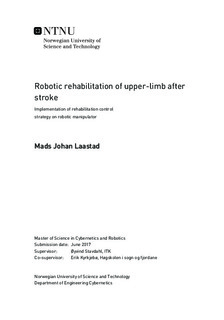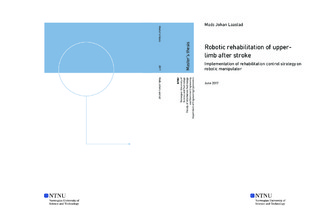| dc.contributor.advisor | Stavdahl, Øyvind | |
| dc.contributor.advisor | Kyrkjebø, Erik | |
| dc.contributor.author | Laastad, Mads Johan | |
| dc.date.accessioned | 2017-09-27T14:02:47Z | |
| dc.date.available | 2017-09-27T14:02:47Z | |
| dc.date.created | 2017-06-08 | |
| dc.date.issued | 2017 | |
| dc.identifier | ntnudaim:16438 | |
| dc.identifier.uri | http://hdl.handle.net/11250/2457156 | |
| dc.description.abstract | Globally, stroke is one of the main causes of permanent neurological damage \cite{WHO}. Partial or total paralysis of the extremities is the most common complication, with paralysis in upper-limbs being the most prevalent. Efficient and available rehabilitation therapy is essential for the patient's recovery process. Traditional physical therapy is a resource intensive and commonly used approach. Research on robotic rehabilitation aims to provide a viable rehabilitation tool.
The main objective of this master thesis is to design and implement a safe real-time control system on an industrial six-axis manipulator with an external force/torque sensor for robotic upper-limb rehabilitation of stroke patients.
The chosen approach is to implement control strategies directly in the tool frame of the manipulator. This is achieved by utilizing the UR5 from Universal Robot and the Mini45 F/T sensor from ATI Industrial Automation. Two verification test are chosen based on activities of daily life (ADL). The best low-level control strategy is achieved by indirect force and torque control through a joint velocity interface.
The UR5 firmware operates with an unknown internal controller. An external controller is designed incrementally to investigate the unknown system dynamics and find the best possible low-level performance. Numerous safety mechanisms are added to the external controller. Four high-level control strategies are developed and implemented.
Three main safety-related challenges with robotic rehabilitation are identified. Two of them are related to and solved by the external force/torque sensor. The third challenge is related to the self-collisions inside the workspace of the UR5 manipulator. This challenge is also applicable to all six-axis robot manipulators. The three challenges are analyzed and solved with a safety-oriented approach.
The safety and functionality of the robotic rehabilitation system are experimentally verified. The behaviour of the rehabilitation modes is analyzed and discussed based on raw data and video recordings.
The conclusion is that robotic upper-limb rehabilitation of stroke patients utilizing the UR5 manipulator and the Mini45 F/T sensor is safe and feasible. | |
| dc.language | eng | |
| dc.publisher | NTNU | |
| dc.subject | Kybernetikk og robotikk, Biomedisinsk kybernetikk | |
| dc.title | Robotic rehabilitation of upper-limb after stroke - Implementation of rehabilitation control strategy on robotic manipulator | |
| dc.type | Master thesis | |

